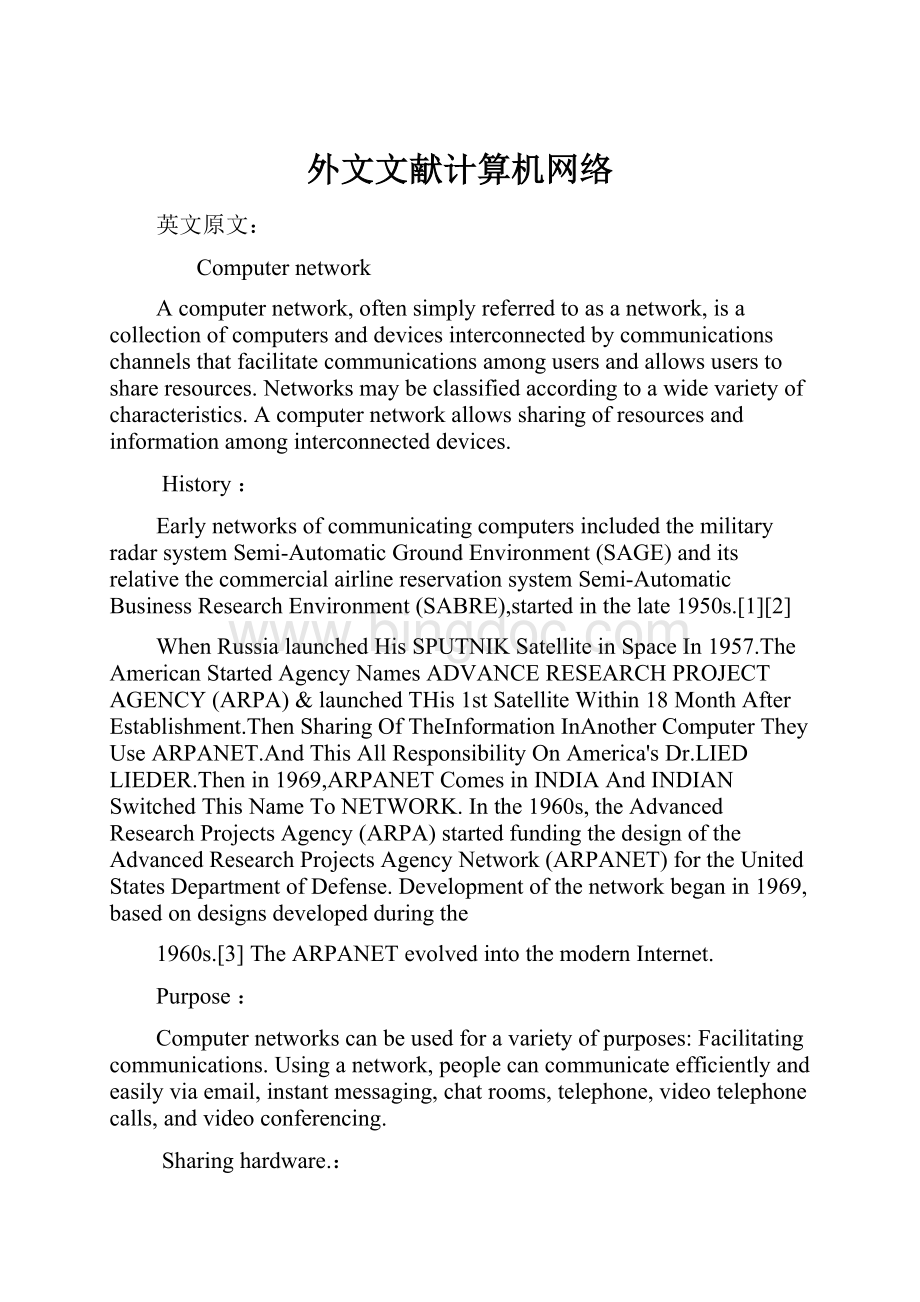外文文献计算机网络.docx
《外文文献计算机网络.docx》由会员分享,可在线阅读,更多相关《外文文献计算机网络.docx(15页珍藏版)》请在冰点文库上搜索。

外文文献计算机网络
英文原文:
Computernetwork
Acomputernetwork,oftensimplyreferredtoasanetwork,isacollectionofcomputersanddevicesinterconnectedbycommunicationschannelsthatfacilitatecommunicationsamongusersandallowsuserstoshareresources.Networksmaybeclassifiedaccordingtoawidevarietyofcharacteristics.Acomputernetworkallowssharingofresourcesandinformationamonginterconnecteddevices.
History:
EarlynetworksofcommunicatingcomputersincludedthemilitaryradarsystemSemi-AutomaticGroundEnvironment(SAGE)anditsrelativethecommercialairlinereservationsystemSemi-AutomaticBusinessResearchEnvironment(SABRE),startedinthelate1950s.[1][2]
WhenRussialaunchedHisSPUTNIKSatelliteinSpaceIn1957.TheAmericanStartedAgencyNamesADVANCERESEARCHPROJECTAGENCY(ARPA)&launchedTHis1stSatelliteWithin18MonthAfterEstablishment.ThenSharingOfTheInformationInAnotherComputerTheyUseARPANET.AndThisAllResponsibilityOnAmerica'sDr.LIEDLIEDER.Thenin1969,ARPANETComesinINDIAAndINDIANSwitchedThisNameToNETWORK.Inthe1960s,theAdvancedResearchProjectsAgency(ARPA)startedfundingthedesignoftheAdvancedResearchProjectsAgencyNetwork(ARPANET)fortheUnitedStatesDepartmentofDefense.Developmentofthenetworkbeganin1969,basedondesignsdevelopedduringthe
1960s.[3]TheARPANETevolvedintothemodernInternet.
Purpose:
Computernetworkscanbeusedforavarietyofpurposes:
Facilitatingcommunications.Usinganetwork,peoplecancommunicateefficientlyandeasilyviaemail,instantmessaging,chatrooms,telephone,videotelephonecalls,andvideoconferencing.
Sharinghardware.:
Inanetworkedenvironment,eachcomputeronanetworkmayaccessandusehardwareresourcesonthenetwork,suchasprintingadocumentonasharednetworkprinter.
Sharingfiles,data,andinformation.Inanetworkenvironment,authorizedusermayaccessdataandinformationstoredonothercomputersonthenetwork.Thecapabilityofprovidingaccesstodataandinformationonsharedstoragedevicesisanimportantfeatureofmanynetworks.
Sharingsoftware.:
Usersconnectedtoanetworkmayrunapplicationprogramsonremotecomputers.
informationpreservation
Security
NetworkclassificationThefollowinglistpresentscategoriesusedforclassifyingnetworks.
Connectionmethod:
Computernetworkscanbeclassifiedaccordingtothehardwareandsoftwaretechnologythatisusedtointerconnecttheindividualdevicesinthenetwork,suchasopticalfiber,Ethernet,wirelessLAN,HomePNA,powerlinecommunicationorG.hn.
EthernetasitisdefinedbyIEEE802utilizesvariousstandardsandmediumsthatenablecommunicationbetweendevices.Frequentlydeployeddevicesincludehubs,switches,bridges,orrouters.WirelessLANtechnologyisdesignedtoconnectdeviceswithoutwiring.Thesedevicesuseradiowavesorinfraredsignalsasatransmissionmedium.ITU-TG.hntechnologyusesexistinghomewiring(coaxialcable,phonelinesandpowerlines)tocreateahigh-speed(upto1Gigabit/s)localareanetwork.
Wiredtechnologies:
Twistedpairwireisthemostwidelyusedmediumfortelecommunication.
Twisted-paircablingconsistofcopperwiresthataretwistedintopairs.Ordinarytelephonewiresconsistoftwoinsulatedcopperwirestwistedintopairs.Computernetworkingcablingconsistof4pairsofcoppercablingthatcanbeutilizedforbothvoiceanddatatransmission.Theuseoftwowirestwistedtogetherhelpstoreducecrosstalkandelectromagneticinduction.Thetransmissionspeedrangesfrom2millionbitspersecondto100millionbitspersecond.TwistedpaircablingcomesintwoformswhichareUnshieldedTwistedPair(UTP)andShieldedtwisted-pair(STP)whichareratedincategorieswhicharemanufacturedindifferentincrementsforvariousscenarios.
Coaxialcableiswidelyusedforcabletelevisionsystems,officebuildings,andotherwork-sitesforlocalareanetworks.Thecablesconsistofcopperoraluminumwirewrappedwithinsulatinglayertypicallyofaflexiblematerialwithahighdielectricconstant,allofwhicharesurroundedbyaconductivelayer.Thelayersofinsulationhelpminimizeinterferenceanddistortion.Transmissionspeedrangefrom200milliontomorethan500millionbitspersecond.
Opticalfibercableconsistsofoneormorefilamentsofglassfiberwrappedinprotectivelayers.Ittransmitslightwhichcantraveloverextendeddistances.
Fiber-opticcablesarenotaffectedbyelectromagneticradiation.Transmissionspeed
mayreachtrillionsofbitspersecond.Thetransmissionspeedoffiberopticsis
hundredsoftimesfasterthanforcoaxialcablesandthousandsoftimesfasterthana
twisted-pairwire.[citationneeded]
Wirelesstechnologies:
Terrestrialmicrowave–TerrestrialmicrowavesuseEarth-basedtransmitterandreceiver.Theequipmentlookssimilartosatellitedishes.Terrestrialmicrowavesuselow-gigahertzrange,whichlimitsallcommunicationstoline-of-sight.Pathbetweenrelaystationsspacedapprox,30milesapart.Microwaveantennasareusuallyplacedontopofbuildings,towers,hills,andmountainpeaks.
Communicationssatellites–ThesatellitesusemicrowaveradioastheirtelecommunicationsmediumwhicharenotdeflectedbytheEarth'satmosphere.Thesatellitesarestationedinspace,typically22,000miles(forgeosynchronoussatellites)abovetheequator.TheseEarth-orbitingsystemsarecapableofreceivingandrelayingvoice,data,andTVsignals.
CellularandPCSsystems–Useseveralradiocommunicationstechnologies.Thesystemsaredividedtodifferentgeographicareas.Eachareahasalow-powertransmitterorradiorelayantennadevicetorelaycallsfromoneareatothenextarea.
WirelessLANs–Wirelesslocalareanetworkuseahigh-frequencyradiotechnologysimilartodigitalcellularandalow-frequencyradiotechnology.WirelessLANsusespreadspectrumtechnologytoenablecommunicationbetweenmultipledevicesinalimitedarea.Anexampleofopen-standardswirelessradio-wavetechnologyisIEEE.
Infraredcommunication,whichcantransmitsignalsbetweendeviceswithinsmalldistancesnotmorethan10meterspeertopeeror(facetoface)withoutanybodyinthelineoftransmitting.
Scale:
Networksareoftenclassifiedaslocalareanetwork(LAN),wideareanetwork(WAN),metropolitanareanetwork(MAN),personalareanetwork(PAN),virtualprivatenetwork(VPN),campusareanetwork(CAN),storageareanetwork(SAN),andothers,dependingontheirscale,scopeandpurpose,e.g.,controllerareanetwork(CAN)usage,trustlevel,andaccessrightoftendifferbetweenthesetypesofnetworks.LANstendtobedesignedforinternalusebyanorganization'sinternalsystemsandemployeesinindividualphysicallocations,suchasabuilding,whileWANsmayconnectphysicallyseparatepartsofanorganizationandmayincludeconnectionstothirdparties.
Functionalrelationship(networkarchitecture):
Computernetworksmaybeclassifiedaccordingtothefunctionalrelationshipswhichexistamongtheelementsofthenetwork,e.g.,activenetworking,client–server,Wirelessadhocnetworkandpeer-to-peer(workgroup)architecture.
Networktopology:
Mainarticle:
NetworktopologyComputernetworksmaybeclassifiedaccordingtothenetworktopologyuponwhichthenetworkisbased,suchasbusnetwork,starnetwork,ringnetwork,meshnetwork.
Networktopologyisthecoordinationbywhichdevicesinthenetworkarearrangedintheirlogicalrelationstooneanother,independentofphysicalarrangement.Evenifnetworkedcomputersarephysicallyplacedinalineararrangementandareconnectedtoahub,thenetworkhasastartopology,ratherthanabustopology.Inthisregardthevisualandoperationalcharacteristicsofanetworkaredistinct.Networksmaybeclassifiedbasedonthemethodofdatausedtoconveythedata,theseincludedigitalandanalognetworks.
TypesofnetworksbasedonphysicalscopeCommontypesofcomputernetworksmaybeidentifiedbytheirscale.
Localareanetwork:
Alocalareanetwork(LAN)isanetworkthatconnectscomputersanddevicesinalimitedgeographicalareasuchashome,school,computerlaboratory,officebuilding,orcloselypositionedgroupofbuildings.Eachcomputerordeviceonthenetworkisanode.CurrentwiredLANsaremostlikelytobebasedonEthernettechnology,althoughnewstandardslikeITU-TG.hnalsoprovideawaytocreateawiredLANusingexistinghomewires(coaxialcables,phonelinesandpowerlines).[4]
Typicallibrarynetwork,inabranchingtreetopologyandcontrolledaccesstoresourcesAllinterconnecteddevicesmustunderstandthenetworklayer(layer3),becausetheyarehandlingmultiplesubnets(thedifferentcolors).Thoseinsidethelibrary,whichhaveonly10/100Mbit/sEthernetconnectionstotheuserdeviceandaGigabitEthernetconnectiontothecentralrouter,couldbecalled"layer3switches"becausetheyonlyhaveEthernetinterfacesandmustunderstandIP.Itwouldbemorecorrecttocallthemaccessrouters,wheretherouteratthetopisadistributionrouterthat
connectstotheInternetandacademicnetworks'customeraccessrouters.
ThedefiningcharacteristicsofLANs,incontrasttoWANs(WideAreaNetworks),includetheirhigherdatatransferrates,smallergeographicrange,andnoneedforleasedtelecommunicationlines.CurrentEthernetorotherIEEE802.3LANtechnologiesoperateatspeedsupto10Gbit/s.Thisisthedatatransferrate.IEEEhasprojectsinvestigatingthestandardizationof40and100Gbit/s.[5]
Personalareanetwork:
Apersonalareanetwork(PAN)isacomputernetworkusedforcommunicationamongcomputeranddifferentinformationtechnologicaldevicesclose